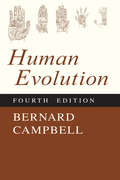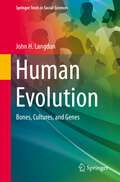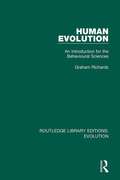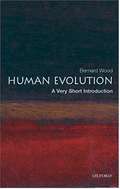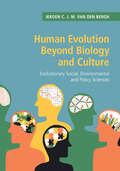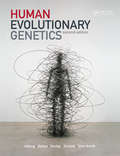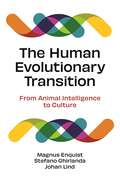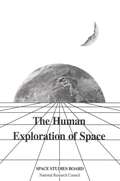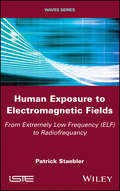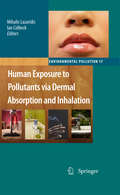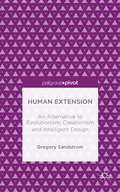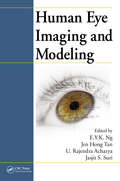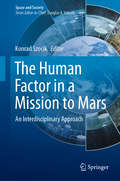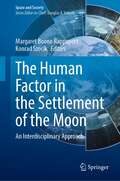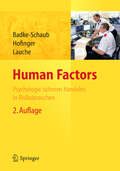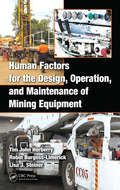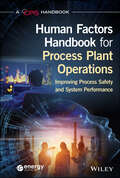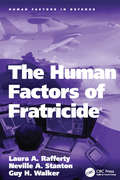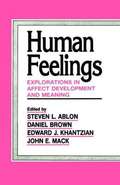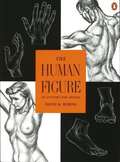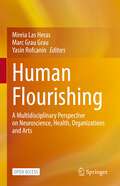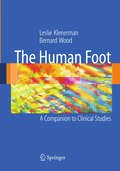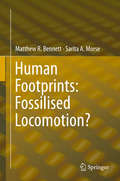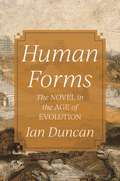- Table View
- List View
Human Evolution: An Introduction to Man's Adaptations
by Bernard CampbellIn this new fourth edition, Campbell has revised and updated his classic introduction to the field. Human Evolution synthesizes the major findings of modern research and theory and presents a complete and integrated account of the evolution of human beings. New developments in microbiology and recent fossil records are incorporated into the enormous range of this volume, with the resulting text as lucid and comprehensive as earlier editions. The fourth edition retains the thematic structure and organization of the third, with its cogent treatment of human variability and speciation, primate locomotion, and nonverbal communication and the evolution of language, supported by more than 150 detailed illustrations and an expanded and updated glossary and bibliography. As in prior editions, the book treats evolution as a concomitant development of the main behavioral and functional complexes of the genus Homo– among them motor control and locomotion, mastication and digestion, the senses and reproduction. It analyzes each complex in terms of its changing function, and continually stresses how the separate complexes evolve interdependently over the long course of the human journey. All these aspects are placed within the context of contemporary evolutionary and genetic theory, analyses of the varied extensions of the fossil record, and contemporary primatology and comparative morphology. The result is a primary text for undergraduate and graduate courses, one that will also serve as required reading for anthropologists, biologists, and nonspecialists with an interest in human evolution.
Human Evolution
by Graeme FinlayControversy over human evolution remains widespread. However, the human genome project and genetic sequencing of many other species have provided myriad precise and unambiguous genetic markers that establish our evolutionary relationships with other mammals. Human Evolution: Genes, Genealogies and Phylogenies identifies and explains these identifiable, rare and complex markers including endogenous retroviruses, genome-modifying transposable elements, gene-disabling mutations, segmental duplications and gene-enabling mutations. The new genetic tools also provide fascinating insights into when and how many features of human biology arose: from aspects of placental structure, vitamin C dependence and trichromatic vision, to tendencies to gout, cardiovascular disease and cancer. Bringing together a decade's worth of research and tying it together to provide an overwhelming argument for the mammalian ancestry of the human species, the book will be of interest to professional scientists and students in both the biological and biomedical sciences.
Human Evolution: Bones, Cultures, and Genes (Springer Texts in Social Sciences)
by John H. LangdonThis is an introductory textbook for the study of human evolution, and covers all major topics of human origins taught under paleoanthropology, anthropology, archaeology, and evolutionary biology courses. This book differs from the existing selection of textbooks in the following ways:• It incorporates the most recent fossil discoveries and interpretations.• It balances the discussion between descriptions of fossils and interpretations of behavior of hominins in different time periods. • It includes current findings of genomics into understanding the more recent stages of human evolution. This important subdiscipline is badly underserved by current texts.• It consistently addresses the relationship of evidence to our current hypotheses and interpretations.The book has an engaging and lucid style suitable for those entering the field. Students will find ample case studies, illustrations and examples helpful in understanding difficult concepts. Tables, timelines, and maps in every chapter include data summaries and key points. The book highlights peripheral points and background concepts in side boxes for easy reference and lists key ideas at the end of each chapter. This up-to-date and easy to read text is suitable for both classroom study and self-learning.
Human Evolution: An Introduction for the Behavioural Sciences (Routledge Library Editions: Evolution #10)
by Graham RichardsOriginally published in 1987, Human Evolution looks at theories of the evolution of human behaviour (contemporary at the time of publication). The book reviews competing theories of psychological and social evolution and provides a detailed historical introduction to the subject. A key theoretical concern which emerges in the book includes the psychological significance of the human evolution issue itself. The period of human evolution covered ranges from the demise of the Miocene hominoids, to the emergence of ‘civilization’. Topics covered include: functions of ‘origin myths’, history of the study of human evolution, methods and data-bases, theories of the nature of ‘hominisation’, origins of bipedalism, language and tool-use, theories of social evolution, theories of cave art and the spread of Homo sapiens to America and Australia.
Human Evolution: A Very Short Introduction
by Bernard Wood"This Very Short Introduction traces the history of our understanding of human evolution - taking the reader right up to the very latest fossil findings and the debates about what they mean." "Providing an 'insider's view' of current paleoanthropology, Bernard Wood explains how human fossils are found, analyzed, and interpreted, and what the latest advances in genetics and a range of other sciences can reveal about our earliest origins."
Human Evolution beyond Biology and Culture: Evolutionary Social, Environmental and Policy Sciences
by Jeroen C. van den BerghBoth natural and cultural selection played an important role in shaping human evolution. Since cultural change can itself be regarded as evolutionary, a process of gene-culture coevolution is operative. The study of human evolution - in past, present and future - is therefore not restricted to biology. An inclusive comprehension of human evolution relies on integrating insights about cultural, economic and technological evolution with relevant elements of evolutionary biology. In addition, proximate causes and effects of cultures need to be added to the picture - issues which are at the forefront of social sciences like anthropology, economics, geography and innovation studies. This book highlights discussions on the many topics to which such generalised evolutionary thought has been applied: the arts, the brain, climate change, cooking, criminality, environmental problems, futurism, gender issues, group processes, humour, industrial dynamics, institutions, languages, medicine, music, psychology, public policy, religion, sex, sociality and sports.
Human Evolutionary Genetics
by Mark Jobling Edward Hollox Toomas Kivisild Chris Tyler-SmithHuman Evolutionary Genetics is a groundbreaking text which for the first time brings together molecular genetics and genomics to the study of the origins and movements of human populations. Starting with an overview of molecular genomics for the non-specialist (which can be a useful review for those with a more genetic background), the book shows h
The Human Evolutionary Transition: From Animal Intelligence to Culture
by Magnus Enquist Stefano Ghirlanda Johan LindA major new theory of why human intelligence has not evolved in other speciesThe Human Evolutionary Transition offers a unified view of the evolution of intelligence, presenting a bold and provocative new account of how animals and humans have followed two powerful yet very different evolutionary paths to intelligence. This incisive book shows how animals rely on robust associative mechanisms that are guided by genetic information, which enable animals to sidestep complex problems in learning and decision making but ultimately limit what they can learn. Humans embody an evolutionary transition to a different kind of intelligence, one that relies on behavioral and mental flexibility. The book argues that flexibility is useless to most animals because they lack sufficient opportunities to learn new behavioral and mental skills. Humans find these opportunities in lengthy childhoods and through culture.Blending the latest findings in fields ranging from psychology to evolutionary anthropology, The Human Evolutionary Transition draws on computational analyses of the problems organisms face, extensive overviews of empirical data on animal and human learning, and mathematical modeling and computer simulations of hypotheses about intelligence. This compelling book demonstrates that animal and human intelligence evolved from similar selection pressures while identifying bottlenecks in evolution that may explain why human-like intelligence is so rare.
The Human Exploration of Space
by Committee on Human ExplorationInformation on the Human Exploration of Space
Human Exposure to Electromagnetic Fields: From Extremely Low Frequency (ELF) to Radiofrequency
by Patrick StaeblerEveryone, whether they like it or not, is exposed to electromagnetic fields, most of the time, at very low levels. In this case, they are inconsequential, but they can cause adverse health effects when they become intense enough. This topic is complex and sensitive.Covering frequencies from 0 Hz to 300 GHz, Human Exposure to Electromagnetic Fields provides an overview of this vast topic. After a reminder of the concepts of electromagnetic fields, the author presents some examples of sources of radiation in daily life and in the industrial or medical sectors. The biophysical and biological effects of these fields on the human body are detailed and the exposure limits are recalled. The exposure assessment and the implementation of the appropriate regulation within companies are also covered.Technically and practically, this book is aimed at people with a scientific background, risk prevention actors, health physicians, especially occupational doctors, and equipment designers.
Human Exposure to Pollutants via Dermal Absorption and Inhalation
by Ian Colbeck Mihalis LazaridisThe human body is exposed to pollution on a daily basis via dermal exposure and inhalation. This book reviews the information necessary to address the steps in exposure assessment relevant to air pollution. The aim is to identify available information including data sources and models, and show that an integrated multi-route exposure model can be built, validated and used as part of an air quality management process. Many epidemiological studies have focused on inhalation exposure. Whilst this is appropriate for many substances, failure to consider the importance of exposure and uptake of material deposited on the skin may lead to an over/underestimation of the risk. Hence dermal exposure is also considered. Drinking water contamination by disinfection by-products is also discussed. Written by leading experts in the field, this book provides a comprehensive review of ambient particulate matter and will be of interest to students, researchers and policymakers involved in air quality management, environmental health and related disciplines, as well as environmental consultants and ventilation engineers.
Human Extension: An Alternative to Evolutionism, Creationism and Intelligent Design
by Gregory SandstromThis book proposes a new angle on the controversy over evolution as a biological theory, creation as a theological/worldview doctrine and evolutionism, creationism and Intelligent Design theory as social ideologies. Rather than presenting a polemic that will enrage or delight one camp or another, this book proposes that a cease-fire is possible.
Human Eye Imaging and Modeling
by E.Y.K. Ng Jen Hong Tan U. Rajendra Acharya Jasjit S. SuriAdvanced image processing and mathematical modeling techniques are increasingly being used for the early diagnosis of eye diseases. A comprehensive review of the field, Human Eye Imaging and Modeling details the latest advances and analytical techniques in ocular imaging and modeling. The first part of the book looks at imaging of the fundus as wel
The Human Factor in a Mission to Mars: An Interdisciplinary Approach (Space and Society)
by Konrad SzocikA manned mission to Mars is faced with challenges and topics that may not be obvious but of great importance and challenging for such a mission. This is the first book that collects contributions from scholars in various fields, from astronomy and medicine, to theology and philosophy, addressing such topics. The discussion goes beyond medical and technological challenges of such a deep-space mission. The focus is on human nature, human emotions and biases in such a new environment.The primary audience for this book are all researchers interested in the human factor in a space mission including philosophers, social scientists, astronomers, and others. This volume will also be of high interest for a much wider audience like the non-academic world, or for students.
The Human Factor in the Settlement of the Moon: An Interdisciplinary Approach (Space and Society)
by Margaret Boone Rappaport Konrad SzocikApproaching the settlement of our Moon from a practical perspective, this book is well suited for space program planners. It addresses a variety of human factor topics involved in colonizing Earth's Moon, including: history, philosophy, science, engineering, agriculture, medicine, politics & policy, sociology, and anthropology. Each chapter identifies the complex, interdisciplinary issues of the human factor that arise in the early phases of settlement on the Moon. Besides practical issues, there is some emphasis placed on preserving, protecting, and experiencing the lunar environment across a broad range of occupations, from scientists to soldiers and engineers to construction workers. The book identifies utilitarian and visionary factors that shape human lives on the Moon. It offers recommendations for program planners in the government and commercial sectors and serves as a helpful resource for academic researchers. Together, the coauthors ask and attempt to answer: “How will lunar society be different?”
Human Factors
by Kristina Lauche Petra Badke-Schaub Gesine HofingerIn Branchen wie Luftfahrt, Kernkraft oder Medizin können menschliche Fehler dramatische Konsequenzen haben. Deshalb werden in Risikobranchen Maßnahmen benötigt, die Fehlerquellen minimieren, sicheres Handeln fördern und dabei den "Faktor Mensch" berücksichtigen. Die Psychologie sicheren Handelns wird im 1. Teil des Standardwerks von Wissenschaftlern erläutert, im 2. Teil stellen erfahrene Praktiker und Wissenschaftler aktuelle Herausforderungen einzelner Branchen vor und präsentieren Lösungsansätze. Mit vielen Fallbeispielen und Praxishinweisen.
Human Factors for the Design, Operation, and Maintenance of Mining Equipment (Human Factors in Mining)
by Tim Horberry Robin Burgess-Limerick Lisa J. SteinerMachines increasingly pervade the mining industry, reducing manual labor and raising production. While the use of new technologies such as remote control, vision enhancement technologies, continuous haulage, and automated equipment has grown, so has the potential for new health and safety risks. Written by leading experts from Australia and North A
Human Factors Handbook for Process Plant Operations: Improving Process Safety and System Performance
by CCPS (Center for Chemical Process Safety)Human Factors Handbook for Process Plant Operations Provides clear and simple instructions for integrating Human Factors principles and practices in the design of processes and work tasks Human Factors, the science of interaction between humans and other elements of a system, draws from disciplines such as psychology, ergonomics, anthropometrics, and physiology to understand how and why people behave and perform as they do—and how best to support them in performing tasks. The goals of the Human Factors approach are to improve human reliability, minimize the risk from human error, and optimize the working environment, human wellbeing, and overall system performance. Human Factors Handbook for Process Plant Operations guides supervisors, managers, and engineers on incorporating Human Factors principles and practices into plant maintenance and operations. With thorough and accessible coverage of all Human Factors topics of relevance to process industries, this easy-to-use handbook uses real-world anecdotes and case studies to demonstrate effective training and learning, task planning, communications, emergency response, risk and error management, and more. Throughout the text, the authors offer valuable insights into why people make mistakes while providing advice on how to help workers perform their process operational tasks successfully. Explains all essential Human Factors concepts and knowledge with clear descriptions and illustrative examples Offers actionable advice and models of good practice that can be applied to design, process operations, start-ups and shut-downs, and maintenance Addresses job aids, equipment design, competence, task support, non-technical skills, working with contractors, and managing change Discusses how lack of Human Factors considerations during the engineering design phase can adversely affect safety and performance Describes how to use indicators to both recognize and learn from human error and performance issues Written by highly experienced operating and maintenance personnel, Human Factors Handbook for Process Plant Operations is an indispensable resource for everyone involved with defining, planning, training, and managing process operations, maintenance, and emergency response in the food, pharmaceutical, chemical, petroleum, and refining industries. The missions of both the CCPS and EI include developing and disseminating knowledge, skills and good practices to protect people, the environment, and property by bringing the best knowledge and practices to industry, academia, governments and the public around the world through collective wisdom, tools, training and expertise. The CCPS, an industrial technology alliance of the American Institute of Chemical Engineers (AIChE), has been at the forefront of documenting and sharing important process safety risk assessment methodologies for more than 35 years and has published over 100 books in its process safety guidelines and process safety concept book series. The EI’s Technical Work Program addresses the depth and breadth of the energy sector from fuels and fuels distribution to health and safety, sustainability and the environment. The EI program provides cost-effective, value-adding knowledge on key current and future international issues affecting those in the energy sector.
The Human Factors of Fratricide (Human Factors in Defence)
by Laura A. Rafferty Neville A. StantonFratricide has been defined as firing on your own forces, when mistaking them for enemy forces, which results in injury or death. Rates of fratricide incidence have been steadily increasing and the complexity of the contemporary operating environment may lead to a continuation of this trend. Although the majority of research into fratricide has focused on the development of technological decision aids, recent explorations highlight the need to emphasise the social aspects within a socio-technical framework. This book presents and validates, via the use of case studies, a model of teamwork and decision-making factors that are associated with incidents of fratricide. In summary, it offers a review and evaluation of contemporary theoretical perspectives on teamwork and fratricide, as well as a range of accident analysis approaches. A novel theory of fratricide is then presented followed by a new methodology for assessing fratricide. Naturalistic case studies of teams are undertaken in the military domain. These studies illustrate the approach and offer early validation evidence. In closing, the book presents a series of principles designed to reduce the likelihood of fratricide in the future.
Human Feelings: Explorations in Affect Development and Meaning
by Steven L. Ablon Daniel Brown Edward J. Khantzian John E. MackDwelling on the importance of emotions in our life, the author through Harvard Affect Study Group has brought together people with different kinds of training to share a passionate interest in the study of affect.
The Human Figure: An Anatomy For Artists
by David K. RubinsA brief yet in-depth presentation of the human anatomy.
Human Flourishing: A Multidisciplinary Perspective on Neuroscience, Health, Organizations and Arts
by Mireia Las Heras Marc Grau Grau Yasin RofcaninThis open access book presents a novel multidisciplinary perspective on the importance of human flourishing. The study of the good life or Eudaimonia has been a central concern at least since Aristotelian times. This responds to the common experience that we all seek happiness. Today, we are immersed in a new paradoxical boom, where the pursuit of happiness seems to permeate everything (books, media, organizations, talks), but at the same time, it is nowhere, or at least very difficult to achieve. In fact, it is not easy to even find a consensus regarding the meaning of the word happiness. Seligman (2011), one of the fathers of the positive psychology, confirmed that his original view the meaning he referred to was close to that of Aristotle. But, he recently confessed that he now detests the word happiness, since it is overused and has become almost meaningless. The aim of this open access book is to shed new light on human flourishing through the lenses of neurosciences and health, organizations, and arts. The novelty of this book is to offer a multi-disciplinary perspective on the importance of human flourishing in our lives. The book will examine further how different initiatives, policies and practices create opportunities for generating human flourishing.
The Human Foot
by Leslie Klenerman Bernard WoodUnique study of the human foot Sole perspective on the human foot in the market
Human Footprints: Fossilised Locomotion?
by Matthew R. Bennett Sarita A. MorseHuman footprints provide some of the most emotive and tangible evidence of our ancestors. They provide evidence of stature, presence, behaviour and in the case of early hominin footprints, evidence with respect to the evolution of human gait and foot anatomy. While human footprint sites are rare in the geological record the number of sites around the World has increased in recent years, along with the analytical tools available for their study. The aim of this book is to provide a definitive review of these recent developments with specific reference to the increased availability of three-dimensional digital elevation models of human tracks at many key sites. The book is divided into eight chapters. Following an introduction the second chapter reviews modern field methods in human ichnology focusing on the development of new analytical tools. The third chapter then reviews the major footprint sites around the World including details on several unpublished examples. Chapters then follow on the role of geology in the formation and preservation of tracks, on the inferences that can be made from human tracks and the final chapter explores the application of this work to forensic science. Audience: This volume will be of interest to researchers and students across a wide range of disciplines - sedimentology, archaeology, forensics and palaeoanthropology.
Human Forms: The Novel in the Age of Evolution
by Ian DuncanA major rethinking of the European novel and its relationship to early evolutionary scienceThe 120 years between Henry Fielding's Tom Jones (1749) and George Eliot's Middlemarch (1871) marked both the rise of the novel and the shift from the presumption of a stable, universal human nature to one that changes over time. In Human Forms, Ian Duncan reorients our understanding of the novel's formation during its cultural ascendancy, arguing that fiction produced new knowledge in a period characterized by the interplay between literary and scientific discourses—even as the two were separating into distinct domains.Duncan focuses on several crisis points: the contentious formation of a natural history of the human species in the late Enlightenment; the emergence of new genres such as the Romantic bildungsroman; historical novels by Walter Scott and Victor Hugo that confronted the dissolution of the idea of a fixed human nature; Charles Dickens's transformist aesthetic and its challenge to Victorian realism; and George Eliot's reckoning with the nineteenth-century revolutions in the human and natural sciences. Modeling the modern scientific conception of a developmental human nature, the novel became a major experimental instrument for managing the new set of divisions—between nature and history, individual and species, human and biological life—that replaced the ancient schism between animal body and immortal soul.The first book to explore the interaction of European fiction with "the natural history of man" from the late Enlightenment through the mid-Victorian era, Human Forms sets a new standard for work on natural history and the novel.
